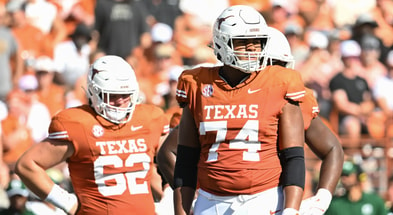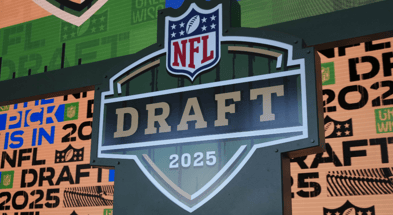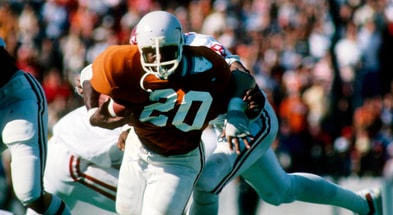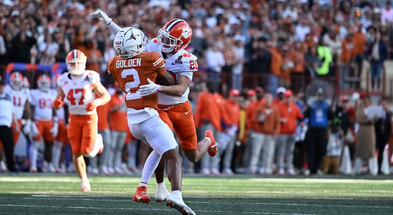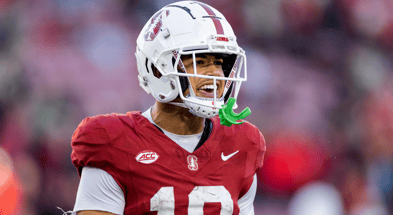How much blue-chip talent is on the Texas Longhorns football roster?

Every year, Bud Elliott of CBS Sports releases the Blue-Chip Ratio. According to Elliott, teams need half of their roster to be made up of players rated as four- or five-stars coming out of high school. It looks at the previous four recruiting classes to determine how many of those prospects joined individual programs.
[Sign up for Inside Texas and get ONE MONTH for $1!]
Elliott uses 247Sports’ rankings to create his list of championship contenders. Texas met Elliott’s threshold with 72 percent of the roster made up of blue-chip prospects. They were joined by…
- Ohio State – 90%
- Alabama – 88%
- Georgia – 80%
- Texas A&M – 79%
- Oregon – 76%
- Oklahoma – 73%
- Texas – 72%
- LSU – 70%
- Notre Dame – 67%
- Clemson – 64%
- Florida – 63%
- Miami – 61%
- Penn State – 61%
- USC – 59%
- Michigan – 56%
- Auburn – 53%
Many of the teams make sense. Some of the numbers do not, as there’s been significant roster turnover with programs like, say, Texas A&M. It’s important to note that Elliott does not factor transfers. If he did, the Aggies would have fallen from 79 percent to 63 percent due to the departures from Aggieland in Jimbo Fisher‘s final two years. Texas would move from 72 percent to 70.
The Blue-Chip Ratio is a great starting point, but what happens when we look at what goes into those percentages?
Let’s bring things back to On3 and use the On3 Industry Ranking. The On3 Industry Ranking is a proprietary algorithm that compiles ratings and rankings from all four primary recruiting media services.
For some classes, there are data points from all four services. On3 ranked the top-300 prospects in 2021 and assigned star ratings to some just outside that group. The 2022, 2023, and 2024 classes, three signing classes that currently make up most of the Texas roster, saw more evaluation and more players ranked.
The On3 Industry Ranking is what we’ll use for this exercise. The dividing line between three-star prospect and four-star talent is drawn where the No. 400 overall prospect in the On3 Industry Ranking is. In the 2024 cycle, Aledo’s Davhon Keys was the last four-star while Tyler High’s Derrick McFall was the highest-rated three-star.
With all that established, lets look class by class at the scholarship players added via high school recruiting still on the Texas roster and see what the blue-chip percentage of that group is
2019: 1-of-1
Blue Chips
- David Gbenda, LB
2020: 3-of-4
Blue Chips
- Alfred Collins, DT
- Vernon Broughton, DT
- Jake Majors, OL
Non-Blue Chips
- Jahdae Barron, DB
2021: 2-of-8
Blue chips
- Morice Blackwell, LB
- Hayden Conner, OL
Non-Blue Chips
- Juan Davis, TE
- Barryn Sorrell, EDGE
- Gunnar Helm, TE
- Max Merril, OL
- Michael Taaffe, DB
- Bert Auburn, K
2022: 11-of-15
Blue Chips
- DJ Campbell, OL
- Kelvin Banks, OL
- Neto Umeozulu, OL
- Justice Finkley, EDGE
- Jaray Bledsoe, DT
- Jaylon Guilbeau, DB
- Jaydon Blue, RB
- Cameron Williams, OL
- Aaron Bryant, DT
- Ethan Burke, EDGE
- Malik Agbo, OL
Non-Blue Chips
- Cole Hutson, OL
- Connor Robertson, OL
- Will Stone, K
- Lance St. Louis, LS
2023: 15-of-22
Blue Chips
- Arch Manning, QB
- Anthony Hill, LB
- CJ Baxter, RB
- Johntay Cook, WR
- Malik Muhammad, DB
- Derek Williams, DB
- Ryan Niblett, WR
- Jelani McDonald, DB
- Colton Vasek, EDGE
- DeAndre Moore Jr., WR
- Tausili Akana, LB
- Derion Gullette, LB
- Jaydon Chatman, OL
- Sydir Mitchell, DT
- Warren Roberson, DB
Non-Blue Chips
- Trevor Goosby, OL
- Liona Lefau, LB
- Tre Wisner, RB
- Connor Stroh, OL
- Spencer Shannon, TE
- Andre Cojoe, OL
- Will Randle, TE
2024: 17-of-22
Blue Chips
- Colin Simmons, EDGE
- Brandon Baker, OL
- Kobe Black, DB
- Ryan Wingo, WR
- Xavier Filsaime, DB
- Jerrick Gibson, RB
- Wardell Mack, DB
- Zina Umeozulu, EDGE
- Aaron Butler, WR
- Jordan Washington, TE
- Santana Wilson, DB
- Trey Owens, QB
- Daniel Cruz, OL
- Christian Clark, RB
- Parker Livingstone, WR
- Jordon Johnson-Rubell, DB
- Tyanthony Smith, LB
Non-Blue Chips
- Alex January, DT
- Freddie Dubose, WR
- Nate Kibble, OL
- Melvin Hills, DT
- Michael Kern, P
Strictly from the high school ranks…
Forty-nine of the 72 players on scholarship on the Texas roster are four-star or better prospects. That’s 68 percent, well above the needed standard. At each position?
- QB: 2-of-2
- RB: 4-of-5
- OL: 10-of-17
- WR: 6-of-7
- TE: 1-of-5
- DT: 5-of-7
- LB: 6-of-7
- DB: 10-of-12
- EDGE: 5-of-6
- Specialist: 0-of-4
What are some of the notable players whose rankings delegated them to three-star status? Jahdae Barron, Barryn Sorrell, Gunnar Helm, Michael Taaffe, Cole Hutson, Tre Wisner, and Alex January fall into this category.
Top 10
- 1New
Shedeur Sanders reacts
To going undrafted in 1st round
- 2
Picks by conference
SEC, Big Ten dominate NFL Draft
- 3Hot
Joel Klatt calls out
'Trash' Shedeur Sanders narrative
- 4
10 Best Available Players
After NFL Draft 1st Round
- 5Trending
ESPN roasted
For Shedeur Sanders empty couch
Get the On3 Top 10 to your inbox every morning
By clicking "Subscribe to Newsletter", I agree to On3's Privacy Notice, Terms, and use of my personal information described therein.
Barron, Sorrell, Helm, Taaffe, Hutson and Wisner all figure to either start or be significant contributors. January is included in this list due to being underrated by other services. On3 was the only service to rank him as a four-star.
What about transfers?
On3 has transfer portal rankings, and the line of demarcation between three-star and four-star was at the No. 120 overall mark. Bai Jobe, who is heading to Kansas, was a four-star. Sorry, Mark Redman. The Louisville Cardinals are only getting a three-star tight end in the No. 121 overall transfer portal prospect.
There are 12 transfers on the Longhorn roster…
Transfer portal: 9-of-12
Blue Chips
- Jay’Vion Cole, DB
- Amari Niblack, TE
- Silas Bolden, WR
- Isaiah Bond, WR
- Trey Moore, EDGE
- Andrew Mukuba, DB
- Matthew Golden, WR
- Gavin Holmes, DB
- Quinn Ewers, QB
Non-Blue Chips
- Jermayne Lole, DT
- Bill Norton, DT
- Tiaoalii Savea, DT
The final total: 58-of-84
Sixty-nine percent of the Longhorn roster, using the On3 Industry Ranking for both high school and transfer portal scholarship players, are Blue Chip recruits.
Steve Sarkisian has repeatedly emphasized the need not just for top-line talent, but also for quality depth. If teams are to play 15 or more games over the course of the season, the nature of the violent game of football will take its toll on a roster. Who replaces a missing starter is important in December and January.
But the overall talent is important in all months of the year, not just in the final stretch. Having talent at each position then developing that talent, deploying it effectively, and doing so within the confines of a healthy culture are things that help win games. Across every position save tight end and specialist, Texas is at or above the 50 percent mark at each position.
- QB: 3-of-3
- RB: 4-of-5
- OL: 10-of-17
- WR: 9-of-10
- TE: 2-of-6
- DT: 5-of-10
- LB: 6-of-7
- DB: 13-of-15
- EDGE: 6-of-7
- Specialist: 0-of-4
[Subscribe to the Inside Texas YouTube channel!]
Do the Longhorns have the talent needed to win a national championship? A more detailed look into the idea of the Blue-Chip Ratio says yes.

